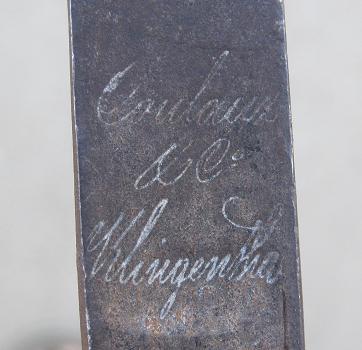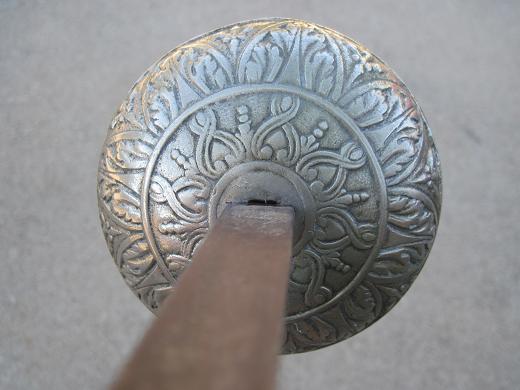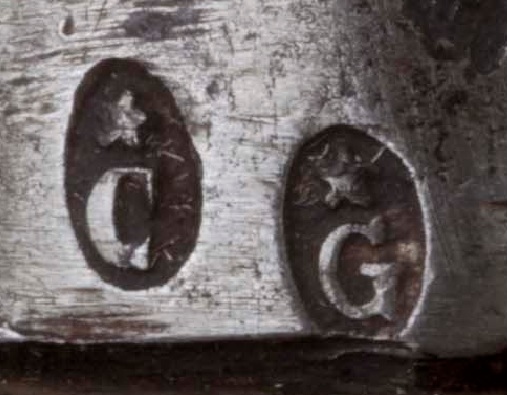| Author |
Message |
|
Ruel A. Macaraeg
|
 Posted: Tue 09 Mar, 2010 10:42 am Post subject: Late French dueling sword Posted: Tue 09 Mar, 2010 10:42 am Post subject: Late French dueling sword |
 |
|
Friends,
I recently obtained what is apparently a late 19th-early 20thc French épée de combat, which the seller had identified as a common fraternal/Masonic sword and accordingly priced on the cheap. I've taken some notes on the épée de combat from Hutton, Holland, and Evangelista here, s.v. "Sword": http://ForensicFashion.com/1889FrenchGentleman.html
Being so recent in time and presumably more abundant, I'm surprised that these weapons don't come up more often in discussion. I wonder if any of you have handled one, and what your impressions are. They're often described as "not real weapons," "harmless," etc., but I find mine to be very lively and dangerous. It handles almost exactly like a fencing foil, with all the speed and precision that implies.
|
|
    |
 |
Sa'ar Nudel

|
 Posted: Tue 09 Mar, 2010 2:04 pm Post subject: Posted: Tue 09 Mar, 2010 2:04 pm Post subject: |
 |
|
Hmmm, I had a brief interest in those and so I had 2-3 in possession. I consider this epee to be the grandson of the rapier and the direct father of the modern, olympic sport epee. More than a weapon, this is a mark of an era and a symbol of social codes. Your item is of fine grade, they were sold in pairs, sometimes with safety blades for training and had the buttons removed before the actual duel. The vintage blades are stiffer than the modern sport blades and the acute point enabled effortless, dangerous & deadly penetration.
Curator of Beit Ussishkin, regional nature & history museum, Upper Galilee.
|
|
   |
 |
|
Grayson C.
|
 Posted: Tue 09 Mar, 2010 2:26 pm Post subject: Posted: Tue 09 Mar, 2010 2:26 pm Post subject: |
 |
|
I've developed an interest in these later sorts of dueling weapons and so I find your example to be ost fascinating. Thank you for the uploaded picture 
Sa'ar, I'm not so sure deadly is the right term. As I understand french dueling at the time, death was never the primary aim. While I have no doubt these weapons could kill (and there are examples, I believe of just that), their "deadliness" has been distinctly handicapped for the sake of speed and lightness.
Just my understanding, I may be wrong.
Grayson
|
|
  |
 |
Sa'ar Nudel

|
 Posted: Tue 09 Mar, 2010 3:30 pm Post subject: Posted: Tue 09 Mar, 2010 3:30 pm Post subject: |
 |
|
Grayson, you are not incorrect. Ususaly a duel of honor (of the late 19th c. - early 20th c.) was settled by the draw of first blood and could be achieved in a matter of seconds, as can be seen in old film footage. However, this weapon with a blade strictly thrusting-oriented, is so fast and its blade so sharp and thin, it is very easy to run one through vital organs or cause an internal bleeding, with just a small amount of pain. Pressure needed to puncture soft body part is merely 2kg!
Here you can see what is believed to be the last public documented duel with sharp weapons (1958!), it is over just after a few seconds:
http://www.youtube.com/watch?v=uL9BWkN-Wcg
The same user posted more duelling videos there.
Curator of Beit Ussishkin, regional nature & history museum, Upper Galilee.
|
|
   |
 |
Vincent Le Chevalier

|
 Posted: Tue 09 Mar, 2010 3:37 pm Post subject: Posted: Tue 09 Mar, 2010 3:37 pm Post subject: |
 |
|
I wouldn't say that these weapons are not deadly, rather the style of their use was heavily geared towards non-lethal combat. I guess if either of the two duelists decided to fight to the death things could get awful pretty fast...
Regards,
--
Vincent
Ensis Sub Caelo
|
|
   |
 |
|
Hadrian Coffin
Industry Professional
Location: Oxford, England Joined: 03 Apr 2008
Posts: 404
|
|
   |
 |
|
Ruel A. Macaraeg
|
 Posted: Wed 10 Mar, 2010 8:15 am Post subject: Posted: Wed 10 Mar, 2010 8:15 am Post subject: |
 |
|
Thanks friends.
My feelings are in line with Sa'ar's and Vincent's -- that given a determination to kill, a duellist would find these more than capable. Given how sharp their points are, and how simple it would be to just extand out and puncture someone, the real skill seems to have been to *avoid* killing your opponent, while giving the impression of trying to....
I also read Nadi's account of his duel in "The Living Sword" recently. I've not yet seen an Italian duelling sword contemporary with the French épée de combat but am let to assume the two forms are similar. The same seems true in Germany based on Hergsell's (1897) Duell-Codex, 2nd edn. Would be nice if some of these non-French examples were available for discussion as well.
|
|
    |
 |
|
William D.
Location: Germany Joined: 03 Sep 2010
Posts: 5
|
 Posted: Fri 03 Sep, 2010 2:01 pm Post subject: Posted: Fri 03 Sep, 2010 2:01 pm Post subject: |
 |
|
Hello @ all,
and especially to Sa'ar (it's been a while...).
I just stumbled across this thread. May I ask if there are any markings on the blade? Is there any chance of getting some closeups of the guard? Perhaps there is more information to be gained from this weapon.
All the best
William
|
|
   |
 |
|
Ruel A. Macaraeg
|
 Posted: Sat 04 Sep, 2010 11:45 am Post subject: Posted: Sat 04 Sep, 2010 11:45 am Post subject: |
 |
|
Hello William,
Here are the close-ups you asked for. The blade is marked "Coulaux & Co[mpagnie] Klingenthal," referring of course to the famous French sword makers. The guard is a disc with a raised radially symmetric floral design. Let us know if these details provide any additional insight!
On a related note, while sorting some of my photos recently, I noticed that I had seen one of these swords at the National Museum of the American Indian on the National Mall, carelessly included in a display of swords representing the European conquests of Native America.
http://forensicfashion.com/1889FrenchGentlemanSword.html
 Attachment: 25.88 KB Attachment: 25.88 KB

 Attachment: 34.84 KB Attachment: 34.84 KB

http://ForensicFashion.com/CostumeStudies.html
|
|
    |
 |
|
Dmitry Z~G
|
 Posted: Sat 04 Sep, 2010 1:22 pm Post subject: Posted: Sat 04 Sep, 2010 1:22 pm Post subject: |
 |
|
Nice epee!
Based on the maker's mark, it dates post-1840.
The so-called 'knight's head' pommels became popular on the French officers' swords from the late Louis XVIth through the Napoleonic period. Here's a French ANXII naval officer's epee from my collection. It dates ca.1804-1815. Note the similar pommel.
Evidently the molds survived and were cast on the fencing and dueling swords pommels well into the 1800s.
 Attachment: 180.27 KB Attachment: 180.27 KB
[ Download ]
Last edited by Dmitry Z~G on Sun 05 Sep, 2010 6:27 am; edited 1 time in total
|
|
  |
 |
Sa'ar Nudel

|
 Posted: Sat 04 Sep, 2010 11:05 pm Post subject: Posted: Sat 04 Sep, 2010 11:05 pm Post subject: |
 |
|
(hello William  ) )
Based upon the amounts of duel epees I've seen and handled in just a short time I would say the knight's head became associated with both dueling and fraternity swords at the second half of the 19th century. I even had an old, high grade foil with a knight's head pommel.
Curator of Beit Ussishkin, regional nature & history museum, Upper Galilee.
|
|
   |
 |
|
William D.
Location: Germany Joined: 03 Sep 2010
Posts: 5
|
 Posted: Sun 05 Sep, 2010 7:14 am Post subject: Posted: Sun 05 Sep, 2010 7:14 am Post subject: |
 |
|
Hello all together,
thanks for the additional pictures Ruel. As you have stated the marks belong to the well known firm Coulaux in Klingenthal at the French-German border (which I may will visit next weekend). It might be interesting which control markings are on the blade. Normally on the other side of the Coulaux marking there are tiny control markings close to the guard. Perhaps you can take a picture of them. They seem to be a remnant of the times when Coulaux worked for the gouvernment and produced military swords. I don't know if they have any further meaning. You might find a list of those different markings and possible datings here:
http://klingenthal.chez.com/zeichen_coulaux.htm
On this page you can also find additional information regarding the history of the Coulaux firm. It would be great if you could post pictures of the markings on your weapon.
Regarding the knights head (by the way: Hello Dmitry  : :
As Sa'ar pointed out, many different styles of weapons were equipped with those knight heads. There are many different styles of those pommels (Greek, Roman, 19th century soldier, even Indian). Their meaning may be a reminder to the wielder of the weapon to fight like the knights in earlier times (chivalry).
So far for today and all the best
William
|
|
   |
 |
|
Dmitry Z~G
|
 Posted: Sun 05 Sep, 2010 10:08 am Post subject: Posted: Sun 05 Sep, 2010 10:08 am Post subject: |
 |
|
| William D. wrote: | Hello all together,
thanks for the additional pictures Ruel. As you have stated the marks belong to the well known firm Coulaux in Klingenthal at the French-German border (which I may will visit next weekend). It might be interesting which control markings are on the blade. Normally on the other side of the Coulaux marking there are tiny control markings close to the guard. Perhaps you can take a picture of them. They seem to be a remnant of the times when Coulaux worked for the gouvernment and produced military swords. I don't know if they have any further meaning. You might find a list of those different markings and possible datings here:
http://klingenthal.chez.com/zeichen_coulaux.htm
|
Hello, William!
Dating this blade is relatively easy. Company was sold by the French government to the Coulaux Freres in 1836. "Coulaux & Cie, Klingenthal" marking was first used in 1840. After 1836 Coulaux did not supply any regulation swords to the French Army, only the officers' privately purchased weapons, sporting swords, perhaps foreign orders, and such. Consequently, because of the lack of governmental supervision, the quality of the blades declined sharply, which , of course, says nothing about this particular blade.
|
|
  |
 |
|
William D.
Location: Germany Joined: 03 Sep 2010
Posts: 5
|
 Posted: Sun 05 Sep, 2010 12:41 pm Post subject: Posted: Sun 05 Sep, 2010 12:41 pm Post subject: |
 |
|
Hey Dmitry,
thanks for the info, but dating the weapon to a time frame beginning in 1840 to the 1st February 1962 (closure of the last hammerwork in Klingenthal) is not exactly what I call "dating" 
Taking into account, that duelling and the use and need for epees for that matter had it's golden age up to WWI, the time frame is limited to 1840 to 1914. According to the web page mentioned earlier, the firm Coulaux started producing fencing material in 1850. So dating means roughly 60 years... 
My personal hope is, that by collecting all possible markings there might be some kind of system. So I'm collecting and hoping for answers 
I have attached an example of those control markings.
All the best
William
 Attachment: 61.93 KB Attachment: 61.93 KB

|
|
   |
 |
Glen A Cleeton

|
 Posted: Sun 05 Sep, 2010 2:09 pm Post subject: Posted: Sun 05 Sep, 2010 2:09 pm Post subject: |
 |
|
Roman Republic busts and helmets as opposed to knightly (imo)?
There are poincons listed in some books.
Cheers
GC
|
|
  |
 |
|
William D.
Location: Germany Joined: 03 Sep 2010
Posts: 5
|
 Posted: Mon 06 Sep, 2010 6:54 am Post subject: Posted: Mon 06 Sep, 2010 6:54 am Post subject: |
 |
|
Hello,
can you tell in which books?
Could be helpful.
Thanks
William
|
|
   |
 |
|
Dmitry Z~G
|
 Posted: Mon 06 Sep, 2010 5:57 pm Post subject: Posted: Mon 06 Sep, 2010 5:57 pm Post subject: |
 |
|
| William D. wrote: |
thanks for the info, but dating the weapon to a time frame beginning in 1840 to the 1st February 1962 (closure of the last hammerwork in Klingenthal) is not exactly what I call "dating" 
|
At least it gives a starting point. The more precise attribution can possibly be deduced from the materials used in the hilt.
|
|
  |
 |
|
William D.
Location: Germany Joined: 03 Sep 2010
Posts: 5
|
 Posted: Tue 07 Sep, 2010 4:13 am Post subject: Posted: Tue 07 Sep, 2010 4:13 am Post subject: |
 |
|
Sorry Dmitry,
my intention was not to critisize you this way. Of course you are right. It'a a starting point.
William
|
|
   |
 |
|
|

